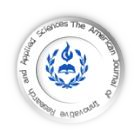



GENERAL INFORMATION

American Journal of Innovative Research & Applied Sciences
Share us on Social Media Links:



| ISSN: 2429-5396 (e) | www.american-jiras.com | Copyright © 2016, ajiras, Atlantic Center for Research Sciences, All Rights Reserved |
| Web Site Form: v 0.1.05 | JF 22 Cours, Wellington le Clairval, Lillebonne | France |
| Web Site Form: v 0.1.05 | JF 22 Cours, Wellington le Clairval, Lillebonne | France |


ResearchBib, Google Scholar, SIS database, i.f.s.i.j, Scribd, IISJ, Eurasian Scientific Journal Index (ESJI), Indianscience.in, arastirmax, Directory of Research Journals Indexing, Pak Academic Sesearch, AcademicKeays, CiteSeerX, UDL Library, CAS Abstracts, J-Gate, WorldCat, Scirus, IET Inspec Direct, and getCited
Indexed by:
| HOME || ABOUT US || ARCHIVES || AIMS AND SCOP || AUTHORS || REVIEW|| SUBMIT MANUSCRIPT || EDITORIAL BOARD || CONTACT US |
| HOME | ABOUT US | ARCHIVE | AIMS AND SCOP | AUTHORS | REVIEW | SUMIBMIT MANUSCRIPT | EDITORIAL BOARED | PUBLICATION FEE |
| | ARTICLES | Am. J. innov. res. appl. sci. Volume 4, Issue 3, Pages 74-84 (March 2017) |
American Journal of innovative
Research & Applied Sciences
Research & Applied Sciences
ISSN 2429-5396 (Online)
OCLC Number: 920041286
OCLC Number: 920041286

|
| MARCH | VOLUME 4 | N° 3 | 2017 |
RESUME
Introduction : La préservation de l’environnement est à présent la base d’un développement durable et, de ce fait, promu tant par les pouvoirs publics que par les industriels. Il est possible de faire de l’environnement un atout, un facteur de développement économique. Les industries agroalimentaires, de par la nature de leurs productions, sont de grandes consommatrices d’eau de très bonne qualité. A l’autre bout de la chaîne, leurs rejets représentent plus de 20 % des eaux résiduaires de l’industrie. Objectif: La gestion de l’eau doit ainsi se réaliser au cœur des systèmes de production, afin non seulement de minimiser mais, également, de maîtriser les dépenses, car les Eaux usées sont des ressources en eau non négligeable. Afin d’aboutir, à des solutions d’épuration qui soient et demeurent techniquement fiables, il convient de maîtriser au maximum les bilans hydrique et la charge polluante dans les ateliers de l’usine. Cette étude quantitative et qualitatives de l’eau industrielle conduit à un prétraitement plus efficace et plus sûr en aval et garantira la qualité des rejets. Matériel et Méthodes : Les caractéristiques physicochimiques de ces eaux trop polluées, nécessitent un certain nombre d’analyse et de mesure à savoir le pH, la température, la Conductivité, les Matières en suspension (MES), les Matières volatils en suspension (MVS), la Demande Chimique en Oxygène (DCO) et la Demande Biochimique en Oxygène (DBO). Résultats : la caractérisation des points de prélèvement d'échantillonnage représentatives montrent que, pour la plupart des paramètres analysés, la pollution des eaux usées rejetées est évidente et que les normes des rejets industriels marocains sont souvent dépassés. Conclusion : L'introduction de solutions pour s'adapter à différentes situations de crise et la mise en place des actions de réduction des pollutions et des consommations à la source, facilite l’envisagement immédiat des prétraitements et des traitements proprement dits. Les valeurs moyennes trouvées dans MES, DBO5 et DCO montre que la charge polluante est essentiellement organique.
Mots clés : rejets industriels, industrie agroalimentaire, valorisation des eaux, qualité des effluents, charge
ABSTRACT
Introduction: The preservation of the environment is now the basis for sustainable development and, therefore, promoted by both public authorities and industry. It is possible to make the environment an asset, a factor of economic development. The agro-food industries, by the nature of their production, are large consumers of water of very good quality. At the other end of the chain, their releases account for more than 20% of the industry's wastewater. Objective: Water management must therefore take place at the heart of production systems, in order not only to minimize but also to control expenditure, as wastewater is a non-negligible water resource. In order to achieve technically reliable sewage treatment solutions, the water balance and the pollutant load in the factory workshops must be kept to a minimum. This quantitative and qualitative study of industrial water leads to a more efficient and safer pre-treatment downstream and will guarantee the quality of the releases. Materials and Methods: The physicochemical characteristics of these excessively polluted waters require a number of analyzes and measurements, namely pH, temperature, Conductivity, Suspended Solids (MES), Suspended Solids (SVM), The Chemical Oxygen Demand (COD) and the Biochemical Oxygen Demand (BOD). Results: The characterization of representative sampling points shows that for most of the parameters analyzed, the pollution of wastewater discharged is obvious and that the standards of Moroccan industrial waste are often exceeded. Conclusion: The introduction of solutions to adapt to different crisis situations and the implementation of measures to reduce pollution and consumption at the source facilitates the immediate consideration of pretreatments and treatments themselves. The mean values found in MES, BOD5 and COD show that the pollutant load is essentially organic.
Keys words: Industrial wastewater, food industry, quality’s characterization, the pollution load.
Introduction : La préservation de l’environnement est à présent la base d’un développement durable et, de ce fait, promu tant par les pouvoirs publics que par les industriels. Il est possible de faire de l’environnement un atout, un facteur de développement économique. Les industries agroalimentaires, de par la nature de leurs productions, sont de grandes consommatrices d’eau de très bonne qualité. A l’autre bout de la chaîne, leurs rejets représentent plus de 20 % des eaux résiduaires de l’industrie. Objectif: La gestion de l’eau doit ainsi se réaliser au cœur des systèmes de production, afin non seulement de minimiser mais, également, de maîtriser les dépenses, car les Eaux usées sont des ressources en eau non négligeable. Afin d’aboutir, à des solutions d’épuration qui soient et demeurent techniquement fiables, il convient de maîtriser au maximum les bilans hydrique et la charge polluante dans les ateliers de l’usine. Cette étude quantitative et qualitatives de l’eau industrielle conduit à un prétraitement plus efficace et plus sûr en aval et garantira la qualité des rejets. Matériel et Méthodes : Les caractéristiques physicochimiques de ces eaux trop polluées, nécessitent un certain nombre d’analyse et de mesure à savoir le pH, la température, la Conductivité, les Matières en suspension (MES), les Matières volatils en suspension (MVS), la Demande Chimique en Oxygène (DCO) et la Demande Biochimique en Oxygène (DBO). Résultats : la caractérisation des points de prélèvement d'échantillonnage représentatives montrent que, pour la plupart des paramètres analysés, la pollution des eaux usées rejetées est évidente et que les normes des rejets industriels marocains sont souvent dépassés. Conclusion : L'introduction de solutions pour s'adapter à différentes situations de crise et la mise en place des actions de réduction des pollutions et des consommations à la source, facilite l’envisagement immédiat des prétraitements et des traitements proprement dits. Les valeurs moyennes trouvées dans MES, DBO5 et DCO montre que la charge polluante est essentiellement organique.
Mots clés : rejets industriels, industrie agroalimentaire, valorisation des eaux, qualité des effluents, charge
ABSTRACT
Introduction: The preservation of the environment is now the basis for sustainable development and, therefore, promoted by both public authorities and industry. It is possible to make the environment an asset, a factor of economic development. The agro-food industries, by the nature of their production, are large consumers of water of very good quality. At the other end of the chain, their releases account for more than 20% of the industry's wastewater. Objective: Water management must therefore take place at the heart of production systems, in order not only to minimize but also to control expenditure, as wastewater is a non-negligible water resource. In order to achieve technically reliable sewage treatment solutions, the water balance and the pollutant load in the factory workshops must be kept to a minimum. This quantitative and qualitative study of industrial water leads to a more efficient and safer pre-treatment downstream and will guarantee the quality of the releases. Materials and Methods: The physicochemical characteristics of these excessively polluted waters require a number of analyzes and measurements, namely pH, temperature, Conductivity, Suspended Solids (MES), Suspended Solids (SVM), The Chemical Oxygen Demand (COD) and the Biochemical Oxygen Demand (BOD). Results: The characterization of representative sampling points shows that for most of the parameters analyzed, the pollution of wastewater discharged is obvious and that the standards of Moroccan industrial waste are often exceeded. Conclusion: The introduction of solutions to adapt to different crisis situations and the implementation of measures to reduce pollution and consumption at the source facilitates the immediate consideration of pretreatments and treatments themselves. The mean values found in MES, BOD5 and COD show that the pollutant load is essentially organic.
Keys words: Industrial wastewater, food industry, quality’s characterization, the pollution load.
*Correspondant author and authors Copyright © 2017:
| Lahoucine Bay 1* | Youssef Ammari 1 | Fouad zouhir 2 | and | Ihya aitichou 1 |
| Lahoucine Bay 1* | Youssef Ammari 1 | Fouad zouhir 2 | and | Ihya aitichou 1 |
Authors Contact
Affiliation.
1. Laboratoire LACAPE | Laboratoire Chimie Appliquée et Environnement |Faculté des Sciences d’Agadir | b.p: 8106 - cité Dakhla, Agadir | Maroc | fax: (+212) 05 28 22 01 00 |
2. Département des Sciences et Gestion de l'Environnement | Université de Liège | Belgique |
This article is made freely available as part of this journal's Open Access: ID | Lahoucine ManuscriptRef.3-ajira020317 |
Research Article
ÉVALUATION DE LA QUALITÉ DES EAUX USEES DES INDUSTRIES DES CONSERVERIES DE POISSON POUR UNE BONNE GERANCE DES RESSOURCES D’EAU
EVALUATION OF THE QUALITY OF CANNERIES FISH INDUSTRIES WASTEWATER’S FOR A GOOD GERANCE WATER RESOURCES
| Lahoucine Bay 1* | Youssef Ammari 1 | Fouad zouhir 2 | and | Ihya aitichou 1 |. Am. J. innov. res. appl. sci. 2017; 4(3):74-84.
| PDF FULL TEXT | |Received | 02 March 2017| |Accepted | 14 March 2017| |Published 21 March 2017 |
ÉVALUATION DE LA QUALITÉ DES EAUX USEES DES INDUSTRIES DES CONSERVERIES DE POISSON POUR UNE BONNE GERANCE DES RESSOURCES D’EAU
EVALUATION OF THE QUALITY OF CANNERIES FISH INDUSTRIES WASTEWATER’S FOR A GOOD GERANCE WATER RESOURCES
| Lahoucine Bay 1* | Youssef Ammari 1 | Fouad zouhir 2 | and | Ihya aitichou 1 |. Am. J. innov. res. appl. sci. 2017; 4(3):74-84.
| PDF FULL TEXT | |Received | 02 March 2017| |Accepted | 14 March 2017| |Published 21 March 2017 |